|
 |
|
Swan Lake (XU XIANGJUN) |
Members of China's Central Ballet will leave February 19 to begin their first U.S. tour. As the latest addition to Sino-American cultural exchanges, the two-month tour underscores the high standards and impressive achievements of Chinese ballet - an artform that was introduced to China only a few decades ago. Despite its youth, the Beijing-based company is an artistically well-balanced group composed of many dedicated dancers, some of whom have won prizes in international competition.
What a coincidence it is that we are leaving one bridge (Beijing's Tianqiao or 'Heavenly Bridge,' the site of the company's home theatre) only to arrive at another bridge (New York's Brooklyn Bridge)!" one company member told me enthusiastically.
The first stop on the company's 11-city tour will be New York, where tour artistic adviser Dai Ailian performed some 40 years ago. Dai has selected a programme intended to demonstrate the company's facility with both classical and modern Western works, as well as showcase its new Chinese-style ballets.
Representing the classical tradition in ballet will be the company's rendition of the second act from Swan Lake which was first performed in China in 1958, and the pas de deux from Act 2 of Giselle. Although the dancers are relative newcomers to classical Western ballet, they received a solid foundation in the style and technique of the Soviet school during the 1950s. The individual artistry of the principal dancers and the harmony and uniformity of the entire corps are outstanding.
Two contemporary works on the programme reflect the progress Chinese dancers have made in recent years in absorbing modem influences from the West. The first is Variations for Four by the renowned English choreographer, the late Sir Anton Dolin. The second, Three Preludes, was choreographed by American Ben Stevenson and is set to music by Rachmaninoff. This pas de deux was first performed in China in 1979 when Stevenson visited as a member of an American cultural delegation. Dolin and Stevenson both made several trips to China to oversee rehearsals of their pieces.
As part of its introduction of new Chinese-style ballets to the American public, Central Ballet will perform Act 2 of New Year's Sacrifice, a four-act dance drama based on a short story by the famous 20th century Chinese novelist Lu Xun. The ballet's theme is the tragic life of a village woman oppressed by the feudal ethical code. In the second act the central character is forced by her cruel mother-in-law to remarry a strange man after the death of her husband. The outwardly happy atmosphere of the pre-nuptial festivities is contrasted with the bride's inward despair. Dramatic tension mounts as the groom finally succeeds in winning the bride's trust and love. The ballet harmoniously combines classical ballet and stylized traditional Chinese folk dance movement to great artistic effect.
Another programme offering is the full-length Chinese dance drama The Maid of the Sea. An epic ballet based on a Chinese folktale, the work tells the story of a beautiful princess of the sea pursued by a fierce demon and rescued by a courageous young hunter who later falls in love with her. The lyricism of the ballet is heightened through romantically expressive pas de seul, pas de deux and group dances.
Character roles in Maid encompass a range of mythologically-animated beings, such as "Old Man Ginseng," and "Snake Maiden," which people the undersea world of fish, seaweed and coral. All this provides a gorgeous array of delicate rainbow hues and shades to the setting. The ballet's often exuberant stylized Chinese folk dances give ample expression to the dancers' virtuoso displays of athleticism.
If the magnificent spectacle afforded by the frankly mythological Maid can be said to be an artistic folk romance, then the powerfully theatrical Sacrifice is obviously a much more realistic work in that it strives to depict the characters' individual personalities and inner bworlds through dance.
Chinese-style pageantry and athleticism combined with the beauty of classical Western technique is the hallmark of ballets being composed in China today. New Year's Sacrifice and The Maid of the Sea are complemented by a third offering on the tour programme, the pas de deux from By the Spring, a work based upon a love story from the minority Yi nationality in southwest China.
The performers
In addition to the dancers and choreographers trained in the 1950s in the Soviet school, Central Ballet will be introducing on this U.S. tour a new crop of dancers who received their training in China in the 1960s and 1970s. One of the more outstanding of these younger dancers is Zhang Weiqiang, who has earned fame for his stage presence, technique and extraordinary elevation. In 1982, 1984 and 1985, Zhang won prizes in dance competitions in the United States, Japan and the Soviet Union.
| 